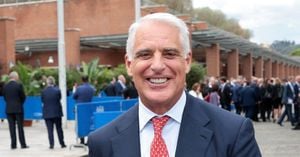Retailers across the U.S. and several other countries were gearing up on November 29, 2024, for what many still regard as the unofficial beginning of the holiday shopping season: Black Friday. Despite earlier promotional pushes luring consumers with deals for weeks leading to this event, the exciting title of Black Friday still holds remarkable sway over shoppers' minds, making it one of the year's biggest retail days. This year, retailers are vying to entice bargain-hunters by advertising bigger discounts than those offered previously.
The energy surrounding Black Friday continues to attract countless gift-seekers, spurring them to make trips to stores — at times when online shopping dominates the buying scene. Grant Gustafson, who heads retail consulting and analytics at Sensormatic Solutions, says Black Friday remains hugely significant for retailers. “It’s important for them to be able to get shoppers inside their stores to show them the experience of browsing and touching items,” he explained. This is especially true when shoppers do their research online. Black Friday is also seen as indicators for the weeks to come. Retailers look closely at foot traffic and sales numbers to forecast their holiday earnings.
Even as many shoppers have shifted to the convenience of online purchases, traditions surrounding Black Friday bring crowds back to physical stores. At Macy's flagship location on Herald Square, New York, foot traffic filled the store as doors opened on the day itself. Discounts soared from 40% to 50% off on various items as customers flooded through the gates. Keressa Clark, 50, and her daughter Morghan, 27, traveled from Wilmington, North Carolina, purely for the thrill. They arrived early, hoping to grab deals. “We don’t have a Macy’s where we’re from,” said Morghan Clark, pleasantly surprised at the plethora of sales available.
The budget of many Americans appears positively influenced by the anticipated return of President-elect Donald Trump. Clark expressed her optimism for the economy, stating she planned to spend around $2,000 this holiday season, up by approximately $500 compared to the previous year. She even welcomed the burden of potential price increases due to tariffs on goods from overseas, claiming support for domestic production.
While positive growth is expected, the consensus among analysts is it may not reach last year's high levels. Many consumers remain tight-fisted with their spending, even as inflation shows signs of easing. The National Retail Federation anticipates consumers will spend between 2.5% and 3.5% more this year than last. So far, online shopping has seen promising results, with reports stating Americans spent $77.4 billion online between November 1 and November 24 — up 9.6% from last year. Adobe, the software company behind the analysis, projects another 8.4% increase for the entire holiday period.
With fewer days separating Thanksgiving and Christmas this year, retailers face extra pressure to attract customers early. The Mall of America, located in Bloomington, Minnesota, set ambitious goals for its Black Friday turnout, emphasizing excitement and tradition beyond just sales. “People come for the excitement, the energy, the traditions surrounding Black Friday,” shared Jill Renslow, the mall's chief business development and marketing officer.
Food and beverage offerings add to the festive atmosphere this time of year. Notably, Target has exclusive products tied to Taylor Swift's Eras Tour, hoping to draw new customers and leverage the star's popularity. Meanwhile, Best Buy has been running promotional sales leading up to Black Friday and will continue through the following weeks. The consumer electronics giant has made its product lineup enticing by releasing deals weekly, seeking to capture buyers’ attention.
Analysts highlight opportunities for impulse shopping during this time, deeming it increasingly important. Impulse purchases can significantly contribute to retail growth, with consumers three times more likely to buy on impulse during physical shopping than through online platforms. Due to this potential, businesses recognize the necessity for shoppers to step inside stores, particularly on Black Friday and during the subsequent days. Marshal Cohen from market research firm Circana noted, “(retailers) are very hungry for Black Friday to do well.”
Similar to previous years, several customers took advantage of special promotions offered exclusively during Black Friday. This year’s deals feature major discounts on electronics, toys, and clothing with retailers promising significant markdowns than previously observed. Indeed, Black Friday traditionally marks the best time for purchasing TVs and other electronics. According to Adobe, those shopping earlier found discounts averaging around 10.8%, but waiting until Black Friday boosts deals beyond 24%.
Though shoppers engaged online primarily during November, they are expected to see prices drop again on Cyber Monday, with expectations for even steeper discounts looming. Previous expectations have set high hopes for the overall holiday shopping season. The reason behind this anticipation lies predominantly with consumers’ growing attention to seeking the best possible bargains.
The significance of Black Friday finance culture endures as consumers navigate through varying economic landscapes. The blend of traditional shopping experience and the expectation for deep discounts breathes vibrancy back to retail. The following weeks post-Black Friday will be decisive, with both excitement and pressure looming over retailers as they refine their strategies for capturing the attention of shoppers throughout Christmas.



